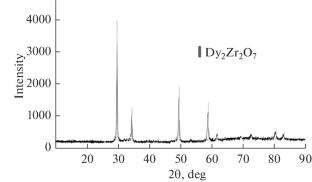机械合成锆酸镝粉坯的致密性和固结性
IF 0.3
Q4 MATERIALS SCIENCE, MULTIDISCIPLINARY
引用次数: 0
摘要
以氧化锆和氧化镝的化学计量混合物为原料,采用机械化学法合成了锆酸镝粉体Dy2Zr2O7。通过x射线物相分析以及透射电镜和扫描电镜分析表明,在机械化学合成过程中,初始氧化锆和氧化镝粉末相互作用30-45 min,形成化合物Dy2Zr2O7。研究了机械合成锆酸镝多晶粉体的工艺性能(流动性、致密性)及其固结后的微观结构。本文章由计算机程序翻译,如有差异,请以英文原文为准。

Features of Compactness and Consolidation of Blanks Made of Mechanically Synthesized Dysprosium Zirconate Powder
Dysprosium zirconate powder Dy2Zr2O7 was obtained by mechanochemical synthesis of a stoichiometric mixture of zirconium oxide and dysprosium oxide. By X-ray phase analysis, as well as transmission and scanning electron microscopy, it has been demonstrated that the initial zirconium oxide and dysprosium oxide powders interact during mechanochemical synthesis for 30–45 min with the formation of the compound Dy2Zr2O7. The technological properties (fluidity, compactibility) of polycrystalline powders of mechanically synthesized dysprosium zirconate, as well as its microstructure after consolidation, have been studied.
求助全文
通过发布文献求助,成功后即可免费获取论文全文。
去求助
来源期刊

Inorganic Materials: Applied Research
Engineering-Engineering (all)
CiteScore
0.90
自引率
0.00%
发文量
199
期刊介绍:
Inorganic Materials: Applied Research contains translations of research articles devoted to applied aspects of inorganic materials. Best articles are selected from four Russian periodicals: Materialovedenie, Perspektivnye Materialy, Fizika i Khimiya Obrabotki Materialov, and Voprosy Materialovedeniya and translated into English. The journal reports recent achievements in materials science: physical and chemical bases of materials science; effects of synergism in composite materials; computer simulations; creation of new materials (including carbon-based materials and ceramics, semiconductors, superconductors, composite materials, polymers, materials for nuclear engineering, materials for aircraft and space engineering, materials for quantum electronics, materials for electronics and optoelectronics, materials for nuclear and thermonuclear power engineering, radiation-hardened materials, materials for use in medicine, etc.); analytical techniques; structure–property relationships; nanostructures and nanotechnologies; advanced technologies; use of hydrogen in structural materials; and economic and environmental issues. The journal also considers engineering issues of materials processing with plasma, high-gradient crystallization, laser technology, and ultrasonic technology. Currently the journal does not accept direct submissions, but submissions to one of the source journals is possible.
 求助内容:
求助内容: 应助结果提醒方式:
应助结果提醒方式:


